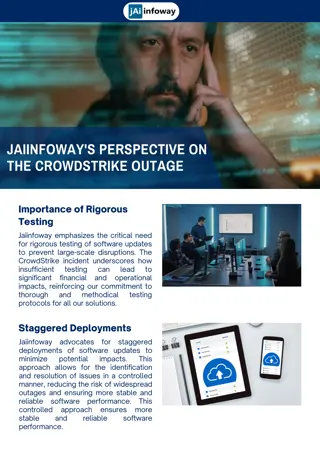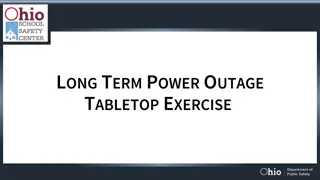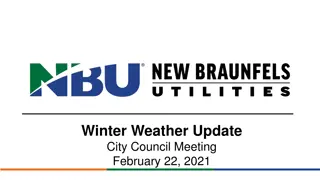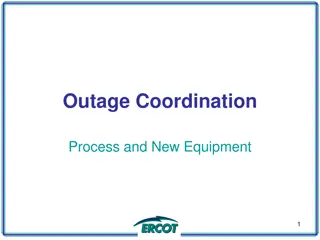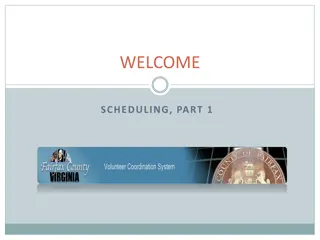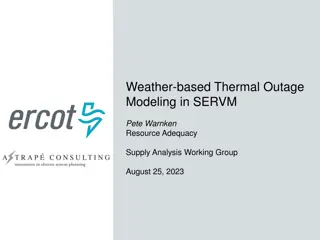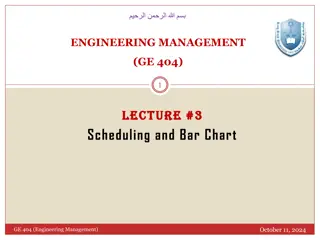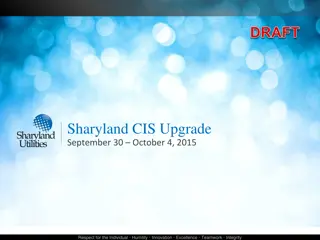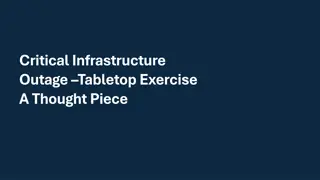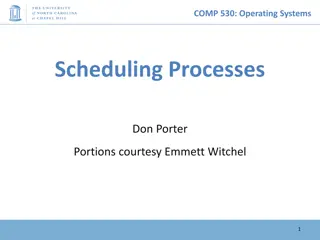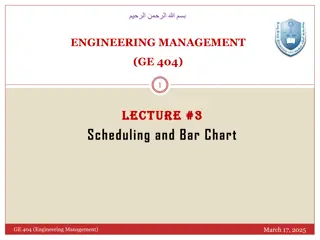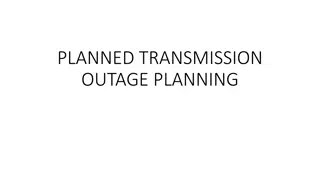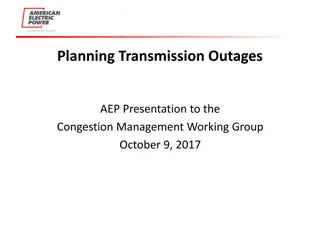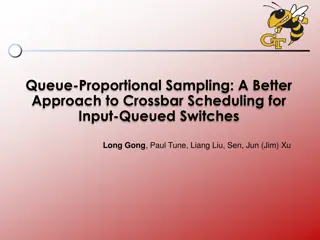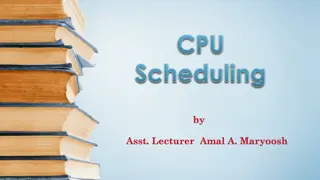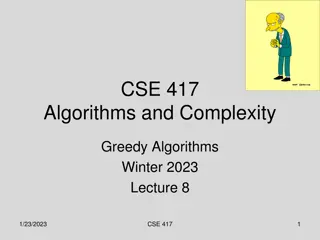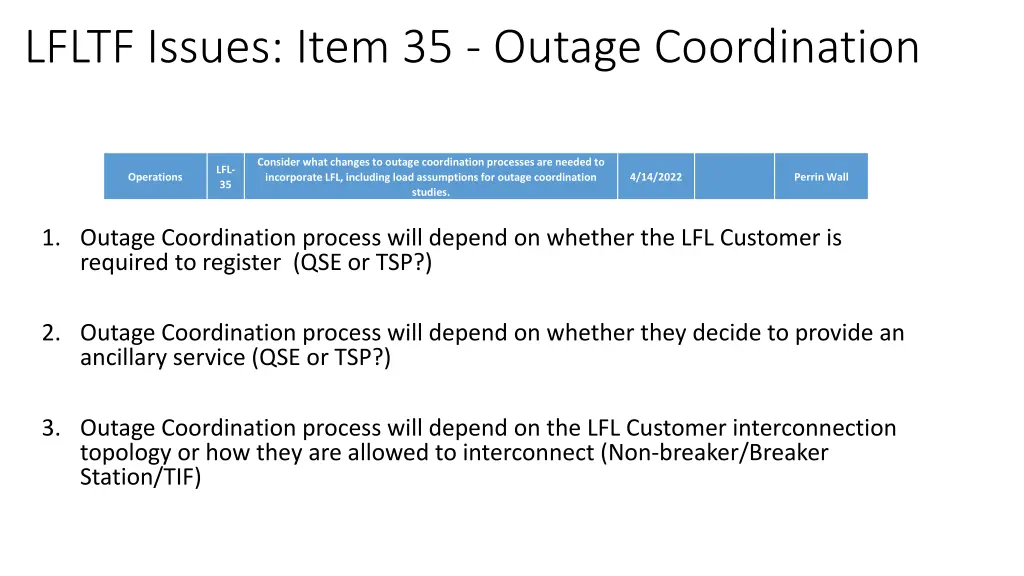
Changes in Outage Coordination Processes for LFL Integration
Explore the necessary changes in outage coordination processes to incorporate LFL, considering load assumptions for outage coordination studies. The process varies based on LFL customer registration, provision of ancillary services, interconnection topology, ERCOT guidelines, load dispatch capabilities, and congestion mitigation. Different scenarios dictate responsibilities between QSE, TSP, and LFL for modeling, telemetry, outage scheduling, and COP submissions.
Uploaded on | 1 Views
Download Presentation

Please find below an Image/Link to download the presentation.
The content on the website is provided AS IS for your information and personal use only. It may not be sold, licensed, or shared on other websites without obtaining consent from the author. If you encounter any issues during the download, it is possible that the publisher has removed the file from their server.
You are allowed to download the files provided on this website for personal or commercial use, subject to the condition that they are used lawfully. All files are the property of their respective owners.
The content on the website is provided AS IS for your information and personal use only. It may not be sold, licensed, or shared on other websites without obtaining consent from the author.
E N D
Presentation Transcript
LFLTF Issues: Item 35 - Outage Coordination Consider what changes to outage coordination processes are needed to incorporate LFL, including load assumptions for outage coordination studies. LFL- 35 Operations 4/14/2022 Perrin Wall 1. Outage Coordination process will depend on whether the LFL Customer is required to register (QSE or TSP?) 2. Outage Coordination process will depend on whether they decide to provide an ancillary service (QSE or TSP?) 3. Outage Coordination process will depend on the LFL Customer interconnection topology or how they are allowed to interconnect (Non-breaker/Breaker Station/TIF)
LFLTF Issues: Item 35 - Outage Coordination 4. LFL Customer s condensed interconnection timeline request will depend on ERCOT provision of Summer Outage Restriction exemptions 5. Outage Coordination process, or the ability to take outages, may depend on ERCOT s ability to dispatch LFL Customer load via SCED (can load be divided in more manageable blocks?) 6. Alternatively, the ability to take outages will depend on Planning process identifying and mitigating potential congestion concerns for maintenance outage conditions (N-1-1)
LFLTF Issues: Item 35 - Outage Coordination Registration If LFL is not required to register as their own entity: If LFL is not providing an ancillary service: Outage coordination process would be as it exists today for Industrial Customers TSP would be required to perform LFL modeling, telemetry and outage scheduling Unlike current industrial customers which provide ancillary services (LRs) for which the TSP continues to be responsible for the overall industrial customer station modeling and telemetry, LFLs should be required to have their overall modeling, telemetry and outage scheduling requirements transferred to a QSE.
LFLTF Issues: Item 35 - Outage Coordination If LFL decides to provide an ancillary service: If LFL Customer decides (or is required) prior to interconnection to provide ancillary service, their QSE should be responsible for its modeling, telemetry and outage scheduling LFL QSE should be required to provide ERCOT outage plans to allow the TSP the opportunity to coordinate outages QSE would be responsible for LFL COP submittal
LFLTF Issues: Item 35 - Outage Coordination If LFL is required to register as a new market participant: A hybrid registration in which the LFL has RE-type requirements to submit modeling data, COPs and coordinate outages but also has TOP-type requirements to participate in UFLS and manual load shed?
LFLTF Issues: Item 35 - Outage Coordination LFL interconnection topology LFL treated as a Generation Resource: Require TSP to build a Transmission Interconnection Facilities (TIF) Disallows non-breaker interconnections for LFL interconnection Would not be allowed to interconnect in a condensed timeframe (6 months or so) and would have to follow TSP minimum TIF interconnection timeframes (18 months?) Would require TSP to be responsible for TIF, and LFL QSE to be responsible for LFL-IF Allows for more TSP control of load especially if crypto popularity expires Prevents transmission connectivity impact (abandoned facilities) if crypto turns out to be a fad
LFLTF Issues: Item 35 - Outage Coordination LFL treated as a regular load customer: Require a breaker interconnection Breaker interconnection minimizes LFL impact of faults on the system as the load wouldn t completely disappear following a fault Easier to coordinate outages since it would not require the LFL customer to be completed de- energized Allowing non-breaker interconnection (tap): If tapped into a line, the totality of the LFL load would disappear and reappear with each reclosing attempt following a fault, potentially putting a strain on the system Taps would also require more coordination with LFL customer given that their facility would have to be completely de-energized preventing them from providing ancillary service
LFLTF Issues: Item 35 - Outage Coordination Summer Outage restriction applicability to LFL interconnection Given the condensed interconnection schedule being requested by LFLs, ERCOT must decide whether exceptions will be made for LFL interconnection during Summer Restriction period it currently does for most Generation interconnections. Given immediate need to serve load, ability to do so during Summer months would have to depend on expected capacity margin projected for Summer and LFL market participation No ancillary service, no Summer energization
LFLTF Issues: Item 35 - Outage Coordination Congestion concerns Consider modifying the Planning process to include the ability to take maintenance outages (N-1-1) to minimize real-time concerns related to having such a large load Also, unlike Generator Resource interconnection studies in which the Resource s ability to output full capacity is not ensured, interconnection studies should make sure that the totality of the LFL load can be served at all times Unless LFL customer will be dispatched by SCED at all times (not only when signing up, day ahead, to provide an ancillary service), totality of load will have to be planned for LFL interconnection timeline may be affected by the need to perform transmission upgrades to allow the TSP to serve the load reliably
LFLTF Issues: Item 35 - Outage Coordination If conditions are such that taking maintenance outages result in congestion due to serving such a large load, would ERCOT allow LFL load to be scalable to mitigate congestion caused by transmission outages Divide LFL load into more manageable blocks that can be dispatched by SCED

